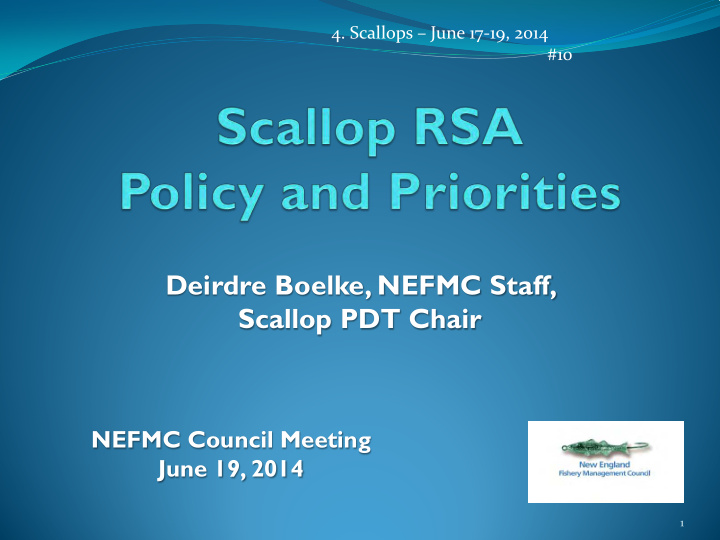



4. Scallops – June 17-19, 2014 #10 Deirdre Boelke, NEFMC Staff, Scallop PDT Chair NEFMC Council Meeting June 19, 2014 1
Background Scallop RSA program began in 1999 Evolved over time but overall 1.25 million pounds set- aside each year to fund research projects ($10-$15 mil) About 10-15 projects are funded annually to about 5-10 different organizations At least biennially the Council recommends the research priorities that are used in the funding announcement 2
Research Topics About half of RSA for surveys Bycatch Monitoring Turtles EFH 3
2014 Awards Recently Announced • 16 projects funded • 1.2 million lbs. from 2014, and 3.5 million lbs. from 2015 RSA 2014 By Subject 2014 By Organization U Delaware VIMS Arnies 9% Biology 12% Survey 14% 35% 37% CFF 25% SMAST 25% Gear Bycatch 9% Bycatch Protected Monitoring ME DMR Resources 6% Habitat and NFI Northeastern 5% 7% enhancement 3% 7% 6% 4
Draft RSA Policy Document #5 Council has received correspondence with questions about Scallop RSA review and selection process To improve transparency recommend including a summary of the process in NEFMC Handbook Overall, RSA Process coordinated by NEFMC and NEFSC - Council sets priorities; NMFS solicits proposals; applications submitted through GRANTS.GOV; 3 independent technical reviews; management review panel meeting (relevant Council, AP , PDT, NEFSC staff, and other individuals); finally NEFSC Director makes final decision since that is a requirement of the NOAA Grants process. Committee reviewed draft policy at May 2014 meeting and approved it without objection 5
PDT Recommendations – April 8, 2014 Document 3 – PDT Memo – Pages 4-5 Appendix 1 - track changes copy of recommendations Take the first three items and put them in priority order: 1. 1) intensive industry-based survey of relevant scallop access areas; 2) intensive industry-based survey areas that may be candidate access areas in the future; and 3) identify and evaluate methods to reduce the impacts on bycatch Clarify the bycatch priority to specifically include mention on 2. windowpane flounder and gear modifications Move #4: broadscale survey under medium priority and clarify the 3. text Combine several of the priorities that are more long-term in nature 4. as medium priority (#8, #9, and elevate #11 from other to medium priority) Remove several priorities that are more appropriate for the 5. assessment process (10a, 10d, 10f, and 10g) 6
AP/Cmte Recommendations – May 20/21, 2014 Meeting summaries - Documents #2 (p.5-7) and #3 (p.5-6) Summary of input Make all surveys the highest priority (access areas, candidate access 1. areas and broadscale surveys equivalent) Second priority should be bycatch studies 2. Third priority should be projects related to other area rotation 3. issues such as predation, seeding, etc. Add a new item under medium – seasonally monitor large 4. recruitment events Shift several priorities around: 5. move habitat higher; move longer-term ocean acidification projects lower; move assessment related priorities lower; and move other surveys outside the surveyed area lower Accept all minor text revisions and deletions suggested by the PDT 6. • Final Committee Recommendations - Document #6 7
Committee Motions Related to RSA Priorities MOTION #7: PIERCE/KAELIN Approve the AP recommendations for 2015 and 2016 Scallop RSA priorities (see Document #6). Failed motion to remove the priorities under “other” Vote on main motion: 8:0:1, motion carried By consensus, the Committee requests that the Council draft a letter to NEFSC requesting that the independent scallop survey meeting be held earlier than the scheduled date of March 2015. Ideally the review could be completed before 2015 RSA award decisions are made. 8
Recommend
More recommend